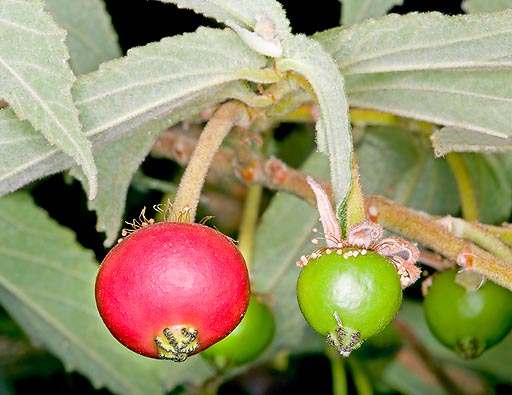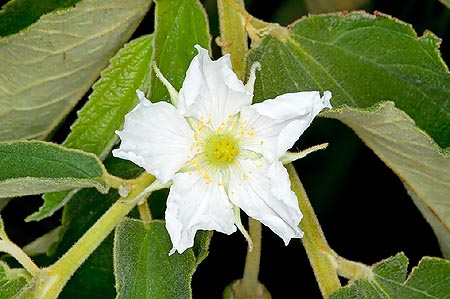Family : Muntingiaceae

Text © Pietro Puccio

English translation by Mario Beltramini

The fruits of Muntingia calabura have a taste of candy floss © Giuseppe Mazza
The Muntingia calabura L. (1753) is native to tropical America: Mexico, Belize, Costa Rica, El Salvador, Guatemala, Honduras, Nicaragua, Panama, Bahamas, Cuba, Hispaniola, Jamaica, St. Vincent and the Grenadines, Trinidad and Tobago, Bolivia, Ecuador and Peru.
The genus is honoured to the Dutch physician and botanist Abraham Munting (1626-1683); the name of the species is one of those under which the plant is locally known.
Common names: “calabur-tree”, “cotton candy berry”, “glade mallow”, “glademallow”, “Jamaica-cherry”, “jam tree”, “manzanil”, “Panama-berry”, “Singapore cherry”, “sirsen”, “strawberry-tree” (English); “bois de soie marron”, “bois d’orme”, “bois ramier”, “cerisier de Panama” (French); “acuruco”, “bersilana”, “bolaina yamanaza”, “bolina”, “cacaniqua”, “capolin”, “capulin blanco”, “capulin de comer”, “cedrillo”, “chirriador”, “chitato’”, “guacimo”, “guinda”, “hembra”, “iumanasa”, “jonote”, “mahaujo”, “majagua”, “majagüillo”, “majagüito”, “memiso”, “memizo”, “mullacahuayo”, “nigua”, “niguito”, “niguo”, “palman”, “pasito”, “tapabotija”, “yunanasa” (Spanish); “calabura”, “pau de seda” (Portuguese); “Jamaica-kirsche”, “Panama-beere”, “Singapur-kirsche” (German).
Evergreen, fast growing, tree, tall up to 10-12 m, with the branches which tend to dispose horizontally, or to hang bending downward, and with ovate-lanceolate, rather wrinkly to the touch, leaves, with pointed apex and toothed edges, long 8-12 cm and 3-5 cm broad, of a dark green colour on the upper side, greyish green underneath.

Flower of Muntingia calabura © Giuseppe Mazza
It reproduces by seed, which has a positive photosensitivity (that is, it germinates only in presence of light), and can fructify already on the first year. Ornamental plant suitable to tropical, and marginally to subtropical, climates, which has spread outside of the origin areas, naturalising and sometimes becoming a nuisance. Besides the fruits, which are regularly produced all over the year, very appreciated, particularly by the kids, for their taste similar to candy floss, the plant provides very good quality firewood, whilst from the bark they get a fibre for ropes.
It is a typical pioneer plant, which adapts to all sort of soil, even if poor, and can bear drought periods. Parts of the plant are variously utilized in the traditional medicine.
→ To appreciate the biodiversity within MUNTINGIACEAE family please click here.
